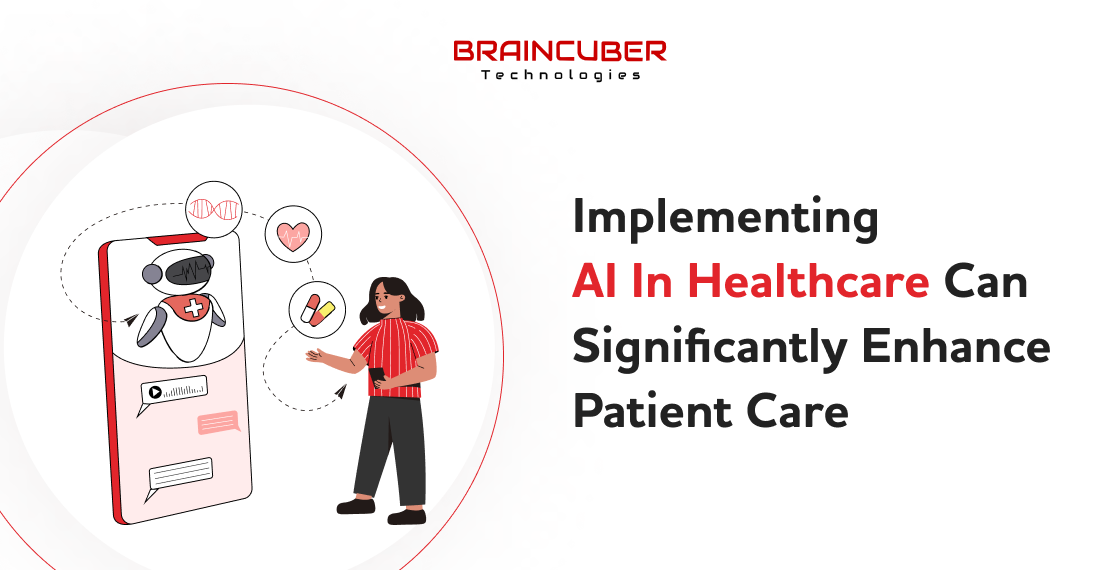Engagement Module
Next Gen AI Solution
Maintenance
Designing
Consultant
Industries
Step-by-Step Guide to Implementing AI in Healthcare

Implementing AI in healthcare requires careful planning and execution to ensure successful integration and optimal outcomes. This guide provides a structured approach to help healthcare organizations navigate the complexities of AI implementation.
Step 1: Assess Your Needs and Define Objectives
1. Identify Pain Points and Opportunities
- Conduct a thorough assessment of your healthcare facility’s operations to identify areas where AI can address existing challenges or enhance performance.
- Common areas for AI application include diagnostics, patient monitoring, administrative processes, and personalized medicine.
2. Define Clear
- Set specific, measurable, achievable, relevant, and time-bound (SMART) objectives for your AI initiative. Objectives might include improving diagnostic accuracy, reducing wait times, or increasing patient engagement.
3. Stakeholder Engagement
- Involve key stakeholders, including healthcare providers, IT staff, and administrative personnel, to gather diverse perspectives and ensure buy-in.
Step 2: Choose the Right AI Tools and Partners
1. Research Available AI Solutions
- Explore various AI technologies and platforms that are tailored to healthcare needs, such as machine learning algorithms, natural language processing, and computer vision.
- Evaluate AI tools based on their functionality, scalability, and ease of integration with existing systems.
2. Select Reliable Vendors and Partners
- Choose reputable AI vendors and partners with a proven track record in healthcare.
- Look for partners who offer robust support and have experience with similar projects.
Step 3: Plan for Integration and Deployment
1. Develop an Implementation Plan
- Create a detailed implementation plan outlining timelines, resource allocation, and key milestones.
- Define the roles and responsibilities of each team member involved in the project.
2. Data Preparation and Management
- Ensure you have access to high-quality data for training AI models. Clean and preprocess data to improve accuracy and reliability.
- Address data privacy and security concerns by implementing strong data protection measures and complying with regulations such as HIPAA.
3. Pilot Testing
- Start with a pilot project to test the AI solution in a controlled environment.
- Gather feedback from users and make necessary adjustments before full-scale deployment.
Step 4: Training and Support
1. Educate and Train Staff
- Provide comprehensive training to healthcare providers and staff on how to use the AI tools effectively.
- Conduct workshops and hands-on sessions to build familiarity and confidence with the new technology.
2. Continuous Support and Improvement
- Establish a support system to address any issues that arise during and after implementation.
- Regularly update the AI system based on user feedback and advancements in technology.
Step 5: Monitor and Evaluate Performance
1. Performance Metrics
- Define key performance indicators (KPIs) to measure the success of the AI implementation. Metrics may include accuracy, efficiency, patient satisfaction, and cost savings.
2. Continuous Monitoring
- Continuously monitor the performance of the AI system to ensure it meets the defined objectives.
- Use analytics to identify areas for improvement and to make data-driven decisions.
3. Periodic Review and Optimization
- Conduct periodic reviews to evaluate the impact of AI on your healthcare facility.
- Optimize the AI system by incorporating new data, refining algorithms, and updating processes as needed.

Implementing AI in healthcare can significantly enhance patient care, operational efficiency, and overall service delivery. By following these steps, healthcare organizations can effectively integrate AI solutions and reap the benefits of this transformative technology.
For more insights and detailed guidance on AI in healthcare, visit our website and explore our range of AI solutions tailored to your needs.
Ready to transform your healthcare facility with AI?
Contact us for free and get to know more about AI solutions we offer!




